Alma Road, Windsor, SL4 3HH
Minister: Rev Vicci Davidson- 07535 511 421
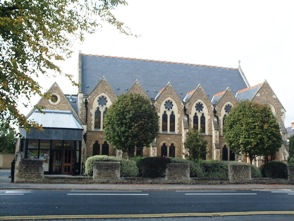
The roots of Methodism in Windsor are very nearly as old as Methodism itself. It was only four months after John Wesley had felt his "heart strangely warmed", during the famous events of 24th May 1738, that he first preached in Windsor. His Journal records quite simply for Tuesday, 26th September 1738, "I declared the Gospel of peace to a small company in Windsor.". That was the first of 14 visits in as many years.
By 1748 John Wesley makes reference to "members of the society" in Windsor, but sadly there are no records tracing further developments until 1800, when a Mr John Ould attended a prayer meeting in Windsor. He became the mainstay of Methodism in Windsor, and it appears that his house was the society's meeting place. By 1815 membership had reached 26, and in the following year a body of Trustees was formed to arrange for the erection of a Chapel, with Rev Thomas Robinson appointed to be the Minister. A small Chapel was duly built in Bier Lane (now River Street) which was a heavily populated area in those days. It soon became too small, and a gallery was added, re-opening in July 1825. The minister, Rev Alexander Strachan, stated:
In no Circuit in which I have travelled these ten years past have I discovered a greater depth of piety or more ardent spirit of prayer of brotherly kindness and charity than exists in the Methodist Society in Windsor.
It was in the Bier Lane Chapel that John Higgs, a native of Maidenhead, was converted in 1829 and he set to work to take Methodism to Maidenhead.
The membership clearly grew well in the early 19th Century and a gallery had to be added to the Chapel. Even so, Bier Lane was bursting at the seams. In 1837, larger new premises were opened just off Peascod Street (now part of King Edward Court). Records do not show why the Peascod Street Chapel lasted only 40 years. There were certainly concerns that it was tucked away down a passage off the street, and presumably a more prominent edifice was considered desirable! And so, in 1874, the Quarterly Meeting gave permission for the erection of a new Chapel at a cost of £6,000. How many millions is that at today's prices? But the worshippers raised the money.
Interestingly, even while raising all this money for the new Chapel, the members continued to care for the needy in their congregation, with sacks of coal distributed at Christmas-time in the 1870s (1 each to 10 households in 1875, 13 in 1876, 14 in 1877, …) and others received monetary gifts, all paid for from the Poor Fund.1
(The Peascod Street Chapel was sold in 1886 and was eventually acquired by the Windsor Steam Laundry Company who used it for 90 years before it was demolished as part of the redevelopment of the area into the King Edward Court shopping complex, opened by Her Majesty the Queen on 8th April 1980.)
In the Spring of 1838, Rev John Ride and Rev Aaron Bell from the Reading (Primitive) Circuit, visited Windsor. (Tragically, in August 1838, when passing through Eton, Rev Aaron Bell turned aside to bathe in a back stream of the Thames, and drowned.2)
The Windsor Mission of the Reading Circuit was established on 5th May 1839. It soon became the Windsor Branch of the Reading Circuit, but was renamed the Maidenhead Branch in 1845, becoming shortly afterwards the Maidenhead Circuit in its own right.
A Chapel was built in Denmark Street, Windsor and the first services were held on 29th May 1853. The Circuit plan for 1858 gives Windsor as holding services at 11 am, 3 pm and 6 pm on Sundays, and 7 pm on Thursdays.
In 1882 the Maidenhead Circuit split, and Windsor became the centre of the new Windsor Circuit.
The society did not prosper, World War 1 took its toll and membership dropped. Shortly after the war, the Society decided they could no longer sustain themselves. The Chapel was closed, and sold to the Church of England to replace the Mission Church in River Street, which had become a clearance area. This continued until the 1960s when the area was rebuilt as the Ward Royal housing complex (opened by the Queen on 29th June 1969).
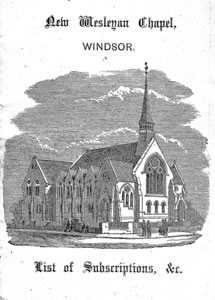
As can be seen in the Alma Road Chapel, the foundation stone of the present Church was laid on 8th May 1876 and the new building opened on 21st February 1877.
The Treasurer's accounts show that the total cost of the new building, including purchase of freehold land and all expenses, was £6,474 14s 5d. £2,000 towards this came from the sale of the Old Chapel, and over £2,500 from subscriptions. By 31st December 1879 the remaining debt had been reduced to about £900. Towards this the Trustees "received the generous offer by the Treasurer of £200 provided the whole amount was realized before August, 1880".3 What an incentive [bribe?] to the other church members!
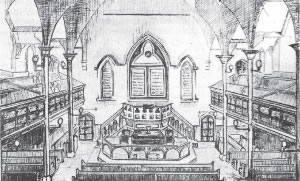
The members were justly proud of their marvellous new Church. It was heated by Grundy's Hot Air Apparatus, with fresh air drawn in at vents on the windowsills. In good Methodist tradition the pulpit was placed centrally, against the south wall, and the organ (erected 27th May 1879) shared the north gallery with the choir for many years.
Just after this, in 1880, Rev Henry L Church was appointed Superintendent of the Windsor Methodist Circuit. Then, as now, the laity in each circuit (currently the Circuit Stewards) have the responsibility of providing and maintaining the manse. Here you can see the inventory of what was provided then, not just for the minister's family, but also for the servants and gardener …
The Church members were very active. A Band of Hope was formed in 1862 and a "Juvenile Missionary Society" in 1869.
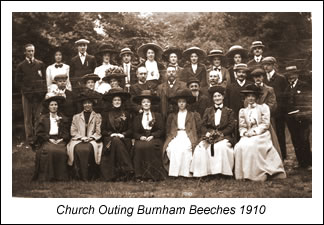
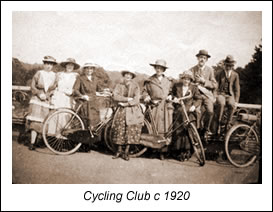
There was a flourishing Sunday School. A summer treat became an annual event, including an enterprising but highly successful outing to Hampton Court in 1872. The following year they went to Burnham Beeches, a venue to which they returned again and again. The teachers used to get to the Church around 6.30 am on the day of the outing to prepare the food. Trestles, forms and everything necessary for the occasion were taken with them in coal carts which were borrowed for the occasion!
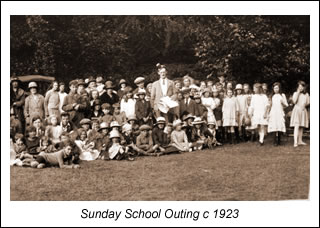
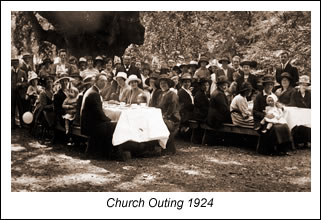
Is it really just a 21st century problem that our churches sometimes find it difficult to fill lay posts? The minutes of a Leaders Meeting in 1882 give the lie to this … The election of Society Stewards was postponed, with those currently in office asked to stay on, due to an "unwillingness to serve" … 4
Over the years collections for the National Children's Home and Orphanage were often taken at special services. In 1907 a house-to-house collection was made on their behalf — an early instance of this fund-raising activity. Members placed great emphasis on helping those less fortunate than themselves. They gave gifts of coal and money to members who had fallen on hard times. In 1877 they subscribed to the Indian Famine Relief Fund, to the New Brunswick Fire Fund, and to the Fund for "Worn Out Preachers"!
The Church was alert to the opportunities for evangelism, and worked amongst the soldiers garrisoned at Windsor Barracks. Mr Brocklehurst founded the Windsor Wesleyan Christian Workers' Association for young people, its main object being evangelism in the neighbourhood, including open air meetings. They also took it upon themselves to keep the boys in the Gallery more orderly! In 1891 they were ordered to move on when conducting an open air service. They decided to send a deputation to the Watch Committee, and meanwhile to take no notice "of the order to move on".
The Wesley Guild was inaugurated in 1895, and Windsor's Guild, started in 1897, met on Wednesdays as it does still.
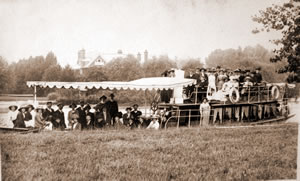
In 1906 the Church and Schoolroom were renovated, a more efficient system for heating the Church was installed, and the organ was moved from the choir gallery to behind the pulpit. The Mayor granted the use of Windsor Guildhall for services for three weeks while the Church was closed. At the re-opening, the ladies wore elaborate hats and some of the men had top hats. An idea of the occasion might be gleaned from this Church members' river trip in 1909.
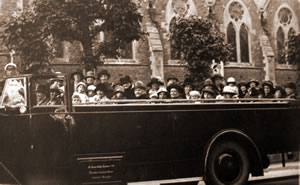
Throughout the twentieth century, although some organisations had their ups and downs, many activities continued to flourish. There was a great sense of community. Scouting was introduced to the Church by Mr Frank Soons in 1915. This was followed by a Cub Pack and then Rovers. Guides started in 1926. Although first and foremost a meeting with a devotional character, the Women's Own took time out for outings, such as the one shown here leaving the Church in 1925. The Sunday School summer outings continued, mainly to Burnham Beeches, but in 1930 a daring innovation was a trip to Bognor.
With the Act of Union in 1932, Alma Road Methodist Church became Windsor Methodist Church.
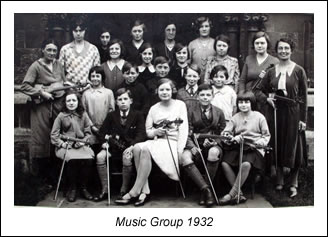
During 1932, James Sankey came to teach in Windsor and became a member. He went to the Gold Coast in 1936 as a member of the Methodist Missionary Society. When he returned to England he trained to become a minister, was ordained, went to India and became a Minister of the Church of South India at its inception.
In 1952 the Young Wives' Club was started for mothers with young children. Shortly afterwards the Ladies' Club was started — an evening meeting open to all women. Also in the 1950s there was a Men's Meeting, and the drama group Windsor Methodist Players started.
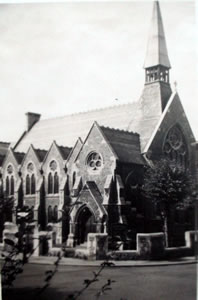
By 1960, the Church premises were showing signs of age, and in 1961 a major renovation scheme was launched linked with the call to Revival. Thanks chiefly to the many regular weekly donations over several years, more than £10,000 was raised, making possible the extensive renovation and re-decoration needed to see the building through the next 30 years.
In the late 1980s there was growing concern about the inadequacy of the Church building, particularly the two-storey Schoolroom section at the rear. After much prayerful study, a large scale Re-Development Scheme was agreed at the daunting cost of £800,000! Under the title Forward in Faith the venture was launched on 3rd June 1990 at a Grand Rally addressed by Viscount Tonypandy. Thanks to the enthusiasm and bright ideas of the Fund-raising Committee, and the dedication, generosity and hard work of very many people, the fund grew and the work began. We were helped very considerably at this time by the kindness of St Edward's Church, who gave us free use of their Schoolroom suite throughout the building phase. And finally, with great rejoicing, the re-developed Church was officially opened by Her Majesty the Queen (accompanied by the Duke of Edinburgh) on 6th April 1993. It was not actually the final step, because fund-raising had to continue for a further 3 years! But on 2nd June 1996, a joyful Thanksgiving Service completed the mammoth task.
In 2007 the Church received a very generous donation covering the cost of upgrading our existing audio system to include projection facilities both in the Church and in the hall downstairs. For major events the system is capable of projecting any activity in the Church, in the hall downstairs, or vice versa.
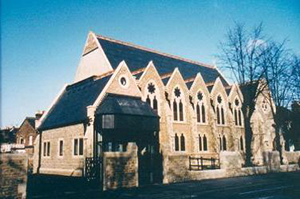
Since the turn of the century, Windsor Church has continued to be highly active. Many of the activities described above continue, and are detailed on the Church's own website. The Church seeks to provide a family friendly environment in which all are enabled to worship God. As well as services in the sanctuary, there is a crèche room connected to the worship area, so parents looking after young children can still share in worship.
The Church's Outreach Committee organises special events and continues to raise money for various causes including the Whitechapel Mission. In some years the young members of Windsor's Junior Mission for All (formally Junior Missionary Association)(JMA) have raised nearly £1,000 for its missionary work.
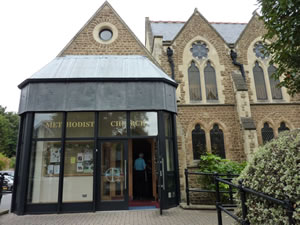
Following the renovation of the Small Chapel at the corner of the Church building, it is open every day for anyone who wishes to come in and pray or leave a prayer request or simply sit quietly for a while. Early morning communion services are also held there.
Within the space of three months in 2014, came the untimely deaths from cancer of three much loved members of Windsor church:
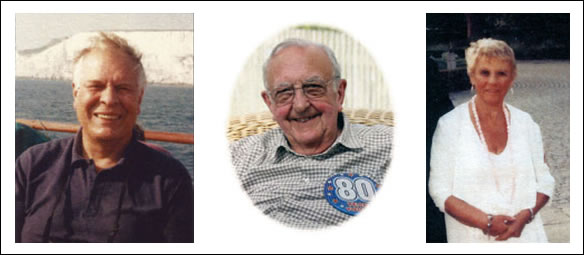
- Thomas Booth ("Tom"), who, with his wife Katie, organised — among other things — Windsor Methodist Church's Wesley Guild for many years.
- Gordon Franklin, CVO, a Local Preacher who had spent a lifetime of service in Her Majesty's Royal Household.
- Ruth Williams, who for many years was pro-active in raising awareness of, and fundraising for, the National Children's Home / NCH / Action for Children, and for which she received the prestigious Stephenson Award.
In September 2015, Windsor Methodist Church held "A Festival of Flowers in Celebration of 'The Word'", raising money for The Thames Hospice and Macmillan Cancer Support, both chosen specifically as all the three members had benefited from the excellent work undertaken by these charities.
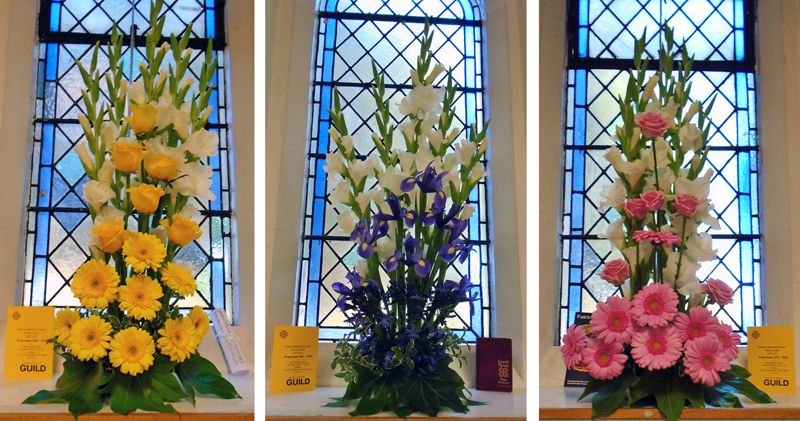
Further pictures from this festival are included in the circuit photo gallery.
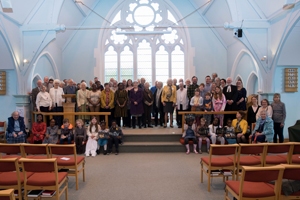
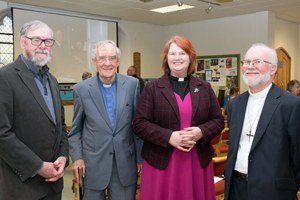 The congregation at the service
The congregation at the service
celebrating the 30th Anniversary
of the re-opening.
Ministers at the celebration weekend: Rev Ken Blake, Rev Dr Malcolm White, Rev Vicci Davidson and Rev Jim Booth (who took the morning service).
On 16th April 2023 Windsor Church celebrated the 30th Anniversary of being officially opened by Her Majesty the Queen (accompanied by the Duke of Edinburgh) following its re-development.
The Methodist Church Windsor. The Centenary Story by Jean Kirkwood, 1977
1. Windsor Wesleyan Methodist Leaders Meeting Minutes 1873-1891
2. History of the Primitive Methodist Church by J Kendall, Volume II
page 345.
3. New Wesleyan Chapel, Windsor, List of Subscriptions, &c. Printed by
J.J.BEECROFT, PRINTER, READING, 1880.
4. Windsor Wesleyan Methodist Leaders Meeting Minutes 1873-1891
Adapted and updated from John Preston's summary and update to Jean Kirkwood's book.
The Old Windsor Methodist Church has now closed.
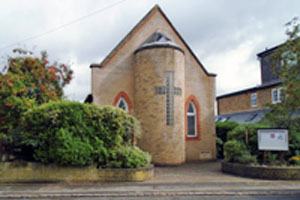
About 1730, Richard Bateman (a friend of Robert Walpole), who had travelled widely, came to Old Windsor and sought to buy an old inn beside the river. Over the next few years he purchased other properties, renamed the inn Grove House and instigated major building works. He housed his "museum" of the many treasures he had collected on his travels in a grand house on the lines of a Chinese cult. In the grounds he built Chinese Pagodas and Indian temples.1
This house is now known as The Priory.
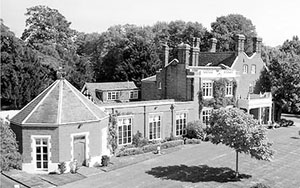
On Friday, 29th November 1771, John Wesley visited Windsor Park, and then went on to Old Windsor, not to preach, but to visit Mr Bateman's house, which he describes in his journal as "the oddest I ever saw with my eyes. … Everything breathes antiquity … everything is quite out of the common way: he scorns to have anything like his neighbours."2
In the first half of the 19th Century, both Wesleyan and Primitive Methodists tried to establish societies in Old Windsor.
As described elsewhere3, Wesleyan Methodism in Windsor was growing steadily by the 1820s. Old Windsor was listed in the Windsor Circuit Preaching Plan in 1826 — three years before John Higgs took Methodism to Maidenhead!
In the Spring of 1838, ministers of the Reading (Primitive) Methodist Circuit visited Windsor, and established the Windsor Mission of the Reading Circuit on 5th May 1839. Their outreach extended to Old Windsor, with weeknight meetings planned:
- In 1839 at both Old Windsor and Old Windsor Common.
- In 1840 only at Old Windsor.
- In 1841 only at Old Windsor Common.
There continued to be a Wesleyan Methodist presence in the village such that, on receipt of an offer of an Iron Chapel, the Leaders Meeting at Windsor Wesleyan Church held an extraordinary meeting in July 1885 to consider its purchase. The Windsor Methodists formed a sub-committee, which concluded after careful investigation that they were unable to find any land to house this Chapel, and the full meeting therefore turned down the offer. Over 60 years were to elapse before Methodism gained a visible presence in Old Windsor.4
However, a group (under the auspices of the Baptist Church) held house meetings in a cottage in Albany Road. As numbers grew, the group moved to the hall of the Boys' School, sited at what is now Croft Corner.
An indenture exists, dated 23rd August 1888, for the sale of a plot of land by George Henry Long of New Windsor to Rev Charles Cole, a Baptist Minister of Windsor, and others for the sum of £96. The plot had a frontage of 48 feet on what is now St Luke's Road and was 133 feet deep. The agreement included a plan on which was marked the site of a proposed galvanised iron building, 18 feet by 24 feet, for use as a Chapel 5, and this was erected in 1889. 6
In the 16th century this piece of ground was part of "The Moor". Over time this area became the Village Green, the last remnant of which is the patch of grass in front of the Fox & Castle Public House. The junction here between what is now St Luke's Road and Crimp Hill was once known as "Stocks Corner" because the village stocks were on the green immediately opposite. A former member maintained that the church might be on the very site where the stocks stood … as the Christians of that era could have built it there to cleanse the site!
5 years later, Rev Charles Cole and friends sold to Henry John Grove of Arthur Road, Windsor and others, the plot and Chapel for £175 for use as a Gospel Mission.7
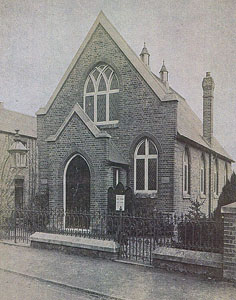
This paved the way for the building of a more permanent House of Worship to replace the Iron Chapel, and the Old Windsor Gospel Hall was built and dedicated in 1897, under the auspices of the London Evangelical Society. This was achieved mainly due to the efforts of Mrs Elizabeth Mercy Nicholson who lived at Bishopsgate, Englefield Green, worshipped at Egham Baptist Church, and lived to the age of 92.8
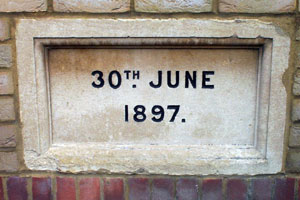
Mrs Nicholson was involved in the setting up of no fewer than five Gospel Halls — Bishopgate Evangelical in Englefield Green, Egham Hythe, Pooley Green and Datchet, as well as the one in Old Windsor. The Old Windsor Hall was built by Mr Groves of Windsor, who apparently underestimated the cost, and lost £100 on the contract.
Mrs Nicholson is reputed to have paid not just for the building but also the stipend of the Church's first minister, Rev Bellchamber and, following his death, that of his successor, Pastor Brown who was likewise appointed by the Evangelical Society.
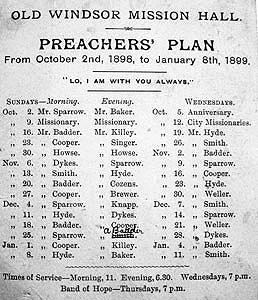
As can be seen from the preachers' plan for the fourth quarter of 1898, the Gospel Hall — described there as the Mission Hall — enjoyed a rota of preachers. Interestingly, Rev Bellchamber is not listed, although his successor, Pastor Brown, is said to have preached each Sunday!
In the early days the regular weekly events were:
| Sunday |
10 am |
Morning School |
|
11 am |
Bible Class for Discussion |
| |
3 pm |
Afternoon School |
| |
6.30 pm |
Evening Service |
| |
followed by |
Prayer Meeting |
| Monday |
7 pm |
Bible Class for Lads |
| Tuesday |
7.30 pm |
Bible Class for Believers |
| Wednesday |
6.15 pm |
Bible Class for Young Women |
| |
7 pm |
Gospel Service |
| |
8 pm |
Singing Class |
| Thursday |
7 pm |
Band of Hope |
… and Breaking of Bread, the First Sunday in each month.
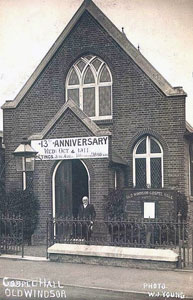
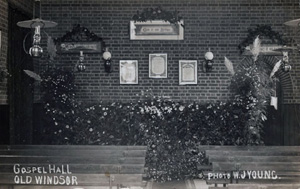
In the years before the First World War, the work flourished, the membership grew and there were many activities. Anniversaries were celebrated such as the 13th illustrated here.
[Years were to elapse before a Milk Float knocked down the iron railings and the brick wall on which they stood as depicted here … and that started a decline in the appearance of the front of the church … ]
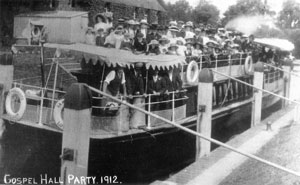
The young people were well catered for, and young and old enjoyed outings on the river Thames!
When Pastor Brown retired in 1928, financial constraints resulted in the link with the London Evangelical Society being severed. The members of the Gospel Hall approached Mr King (a master baker) and Mr Alfred Elisha (the local nurseryman with large greenhouses on the corner of St Luke's Road and Albany Road, and known as "The Prophet"), who both transferred from their Churches in Windsor and, with others, took over the running of the Old Windsor Gospel Hall.
Reminiscing 50 years later, a later stalwart of the church, Mr F W Kimber, who first came to the Gospel Hall in 1914, recalled that Pastor Brown was known as "The Bishop", and also described Mr King as "a very live wire whose voice filled the Hall when singing, and when praying brought us into the real presence of God".9
Selected preachers from various Non-Conformist Churches — Baptists, Methodists, Congregationalists and the Assembly of Open Brethren — agreed to come and preach at their own expense. One preacher, refusing public transport on a Sunday, rode over on his horse from Chertsey!
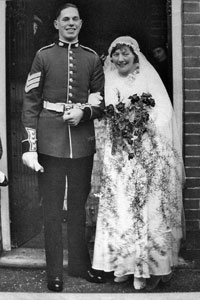
In his review of the year 1936, the chairman of the Management Committee (the Trustees) reported that the congregation at the Sunday morning services was around 25 to 30. Also that year, the Gospel Hall was licensed for matrimony, and its first wedding took place — between Harry Arthur Solley and Freda Elizabeth Ruth Bellamy. The bride was the Church organist, who had "spent her life with us at this Gospel Hall as baby, child and maiden".10
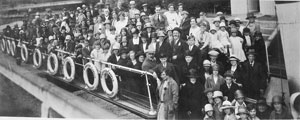
Throughout the years the Sunday School continued to flourish, with both morning and afternoon classes and up to 100 children attending. Every Summer there was a Sunday School outing. At one stage the outings were to Burnham Beeches by horses and carts, and later by charabancs to the seaside. There were days on the river, hiring the "Windsor Castle" (the largest steamer available) to travel to Marlow or Hampton Court. In the 10 year review following the 1928 changes, specific mention was made of "the wonderful Sunday School outings our children have enjoyed".11
In the 1930s the junior section of the Band of Hope, the Little White Ribboners, also met.
Inevitably, the Second World War had a major impact on the society, quite apart from those directly involved in the fighting. For example:
- On 21st May 1940, when the annual election of officers was held, all those then in office were unanimously re-elected for the duration of the war.
- At the meeting on 25th February 1941 the decision was taken to remove the electric bulbs from the outdoor lamps for the duration of the war.
- The numbers attending Sunday School were swelled by evacuees.
- The trustees decided in 1943 to suspend their meetings "till things were cleared up after the war".12
Mr Harold Collingwood recalls his first visit to the Old Windsor Mission. It was 1940 and he was asked to step in as preacher for Mr Bob Anderson of Datchet, who had been called up for fire brigade duty. This was the first of his 55 preaching visits to the Gospel Hall. The preaching plan in those days took the form of a card, on which each visiting preacher was asked to plan his next visit on a Sunday of his choice.13 (This method of appointing preachers was superseded in 1952 by the Methodist Circuit preaching plan.) [However, the Collingwoods' association with Old Windsor did not end there, as in 1979/80, when the church's minister, Rev Donald Mason was ill, Harold's wife, Deaconess (Sister) Daphne, looked after the society for a year.]
The first post-war meeting of the Trustees was in June 1949. Although the church had been kept open during the war years, members were by this time struggling, and many of the principal leaders of the Gospel Hall had died, including Messrs King, Elisha, Badder and Bellamy. A meeting was held on 25th May 1949 "to inform the members what position we stood in, and to try and form a new management to obviate the necessity of closing the Church, [despite it having a flourishing Sunday School]. The surrounding churches have been sounded but are not eager for an amalgamation." 14
A year later members were in a much more positive mood, and, while still looking for help, especially with visiting, they were making plans for improving the premises with a thorough spring clean, providing a rack for bicycles, and planting trees on either side of the Hall. The garden had often seemed more trouble than it was worth! In 1948 one item listed under abnormal expenditure in the accounts was 13/4d "for potato seed to clean the ground"15, and the trustees in 1952 agreed "that weedkiller be used to keep down the growth of weeds, and an attempt be made to economise in the expense of the upkeep of the garden".16
However, the society was having more and more difficulty in finding preachers, and the Gospel Hall members decided to look into union with the Methodist Church, resulting in a visit by Rev James Ingham on Friday, 13th June 1952, to speak about the pros and cons of union. The following week (Thursday, 19th June 1952), at a specially convened meeting the trustees and members of the Gospel Hall agreed unanimously to apply for union with the Methodist Church.
At their Quarterly Meeting, the Windsor and Maidenhead Circuit of the Methodist Church unanimously accepted the application. This was reported to the Management Meeting of the Gospel Hall on 16th September 1952. (Interestingly, the minutes of this meeting were never signed … as it was the final meeting of the Gospel Hall trustees!)
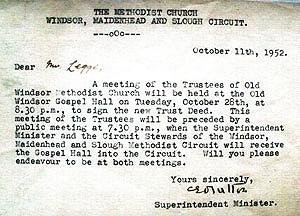
The inaugural meeting of the Old Windsor Methodist Church Trust took place on 28th October 1952 with Rev James Ingham and the Superintendent, Rev Oliver Sutton, both present. The negotiations regarding the Old Windsor Gospel Hall were now complete. The Deed brought to this meeting for signature secured the vesting of the property in a body of Methodist trustees upon trusts of the Methodist Model Deed dated 15th December 1932 so far as they apply in addition to, and in aid of, the existing scheme of trusts. The new trustees (14 local members and 10 from other parts of the circuit) expressed their pleasure in receiving the property within the fellowship of the Methodist Church, and opined that "the society was indeed fulfilling the purposes of those who originally erected the place for worship".17
[Times were still hard … Members decided to purchase only a dozen Methodist hymn-books and one music copy … Two members agreed to ask around the circuit to see whether any Churches had unwanted copies!]
The union with the Methodists had some interesting implications. For example, because of the change of denomination, the previous registration for the solemnisation of marriages had become void. The Trust decided not to re-register immediately (but later did so in 1955). The question of insurance was reviewed, and the existing fire insurance policy with the County Fire Office was terminated on its date of expiry, and a new comprehensive policy was taken out with the Methodist Insurance Company.
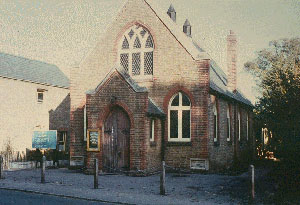
Throughout the 1950s the Church's youth work grew rapidly, to such an extent that by the end of the decade the decision had been taken to extend the premises. By that stage, each Sunday saw three Sunday School classes held in the main church and one in the vestry. The annual Sunday School outings required two and on occasion three coaches — in those days going always to Bognor Regis because one of the leading Sunday School teachers, Mrs Belcher, had friends there!
On 16th June 1959 a fête, held on the local recreation ground, raised £200 and the serious business of building the hall was set in motion. Within 3 months (September 1959), Mr E Cox — who had offered his services free of charge — was appointed as the architect for a new hall. At a special meeting of the Trust in September 1961, he presented the plans for a building costing £4,500. The minutes record that "all present agreed they were satisfactory" 18(!) and the go-ahead was given.
Three tenders for the new hall were considered in July 1962, and that from R E Wood of £4,292 was accepted. This figure included alterations inside the church (removing the old slow combustion stove and refurbishing the floor on which it stood, installing new heaters on the walls and disposing of the old tubular heaters) and the provision of a layby.
The money was raised through the efforts of church members (especially the ladies!), through grants from the London Mission, the Methodist General Chapel Fund and the Joseph Rank Trust, plus gifts from members of the First United Methodist Church of Sacramento, California, including Mr and Mrs Bovey (American relatives of Mrs Pitcher, a leading member of the church).
Also in 1962, the trustees took the decision to switch to electricity for heating. No longer must "a long shovel and a full coal scuttle be always left in the vestry"!19
The church gratefully accepted a new pulpit Bible from an anonymous donor, and agreed to give the old one to Cheapside — another of the Methodist Churches in the Windsor and Maidenhead circuit.20
The new hall was built. It was opened and dedicated on 15th June 1963 by the Baroness Schröder from Englefield Green (who had also opened the fête in 1959).
In view of the death of a number of older members, and others not wishing to serve, a new Trust was constituted in May 1970 comprising 16 local members and 8 from other parts of the circuit.
The work among young people continued to grow. Major work was carried out on the building in 1972. The inside of the Church was "turned round" and modernised, a vestry/meeting room was added, and the current side entrance incorporated. Unfortunately, planning regulations then meant that the front entrance porch, a feature of the original building, had to be removed to provide space for car parking.
The re-opening dedication service was held on 20th May 1972, led by Rev Eddie Heap.
In the late 1970s the old wooden pews (bring your own cushion) were replaced by chairs. The pews were sold for garden seats and went like "hot cakes" and the congregation no longer stuck to them during hot Sunday services! Also, a new organ replaced the original (organists, pump with your feet) one.
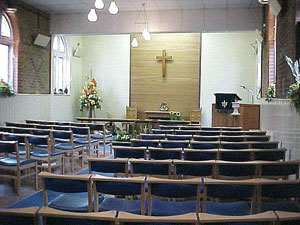
The 1970s and 1980s were vintage years for the Church. The (Methodist) membership reached its peak of 45, and its Youth Groups, Junior Church and Bible Classes flourished.
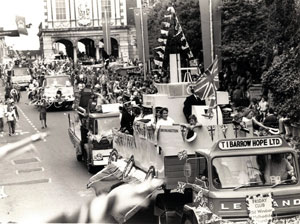
The youth clubs were very active; they enjoyed taking part in Old Windsor's annual Carnival, and the Friday Club also took part in Windsor's celebrations for the Queen's Silver Jubilee in 1977.
This was followed by a period of decline. With, for example, the growth of alternative youth activities in Old Windsor on Sunday mornings, numbers, particularly of young people, dropped.
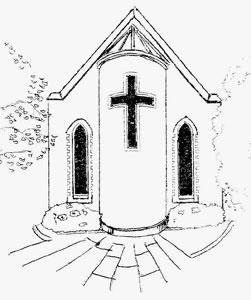
In the mid-1990s, under Rev James Booth, members developed a "vision" of how they would like their Church to develop.
In 1995 a new beginning was made in their ministry with the appointment of a lay worker. The Church benefitted from increased outreach, contact with the village's children through the Junior Church and a Holiday Club, and additional pastoral support for the members.
On 17th May 1997, their Centenary Challenge was launched with a "Centenary Challenge" Service at which the Chairman of the London South West District, Rev R Martin Broadbent gave the address. £100,000 project. 50% raised by members with a series of fund-raising events.
Completed in May 2000, this gave the church its current attractive exterior with its glass cross visibly proclaiming to all passers-by that it is a CHURCH (good-bye, 1970s planning regulations).
The hall and vestry/meeting room were renovated. Other improvements included an enlarged, welcoming entrance area, gas-fired central heating, a larger modernised kitchen and revamped toilets, including facilities for the disabled.
The re-opening celebrations on 20th May 2000 centred round a special service led by Rev James Booth. (What a splendid choice of date! The re-dedication following the re-build in 1972 was likewise on 20th May.)
The following year a Flower Festival was held on the theme of favourite hymns, such as "Thine be the Glory".
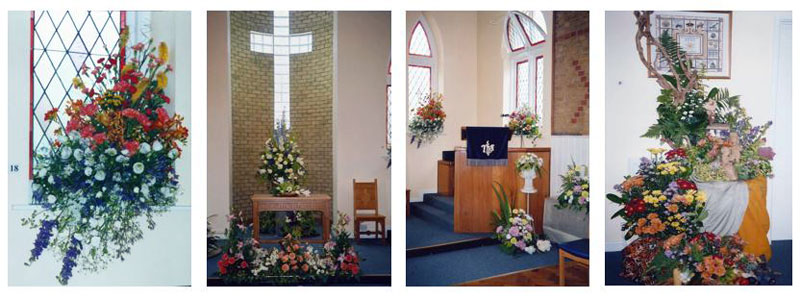
On 12th April 2007 the Church held the first in its now regular series of Traveller's Tales with 4 or 5 every year since then. It is a method of outreach which provides entertainment and instruction for its members, and brings in visitors.
Noting that a large number of churches, particularly in small rural communities, were closing, in 2008 the Thames Valley Circuit decided to give extra support to the six churches with the smallest, and in most cases, ageing congregations. Arising from this, Old Windsor was inspired to hold a series of outreach events called "Come, Taste and Sing", as illustrated here:
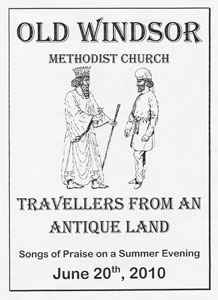
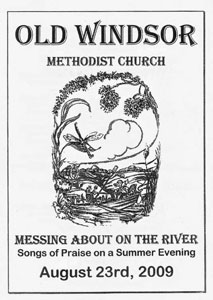
The members continued to meet faithfully over the years. However, the number attending dwindled considerably. This, coupled with the need to finance expensive repairs to the building, brought the question of the continuing viability of the Society. In January 2021 the Church Council decided to put in place an end of life plan, and at an extraordinary meeting on 25th February 2021, the Church Council – prayerfully but with sadness of heart – voted to seek permission to cease to meet as a Society. In line with Methodist Standing Orders, assent was duly given by the Thames Valley Circuit Meeting and by the South East District Council. With the pastoral concerns of every member taken into account, the church held a final act of worship on Sunday, 26th September 2021 – a service celebrating all that the members had achieved in their witness over the years.
1. For a biography of Richard Bateman, see David Nash Ford's Royal Berkshire History"
2. Journal of John Wesley, 29th November 1771.
3. See on this website, A HISTORY OF WINDSOR METHODIST CHURCH
4. Windsor Wesleyan Methodist Leaders Meeting Minutes 1873-1891
5. Document in Circuit Safe.
6. Kirkwood, Windsor Centenary Story p. 27.
7. Document in Circuit Safe.
8. Mrs Nicholson died in 1927 and is buried in Englefield Green Municipal Cemetery.
9. Letter from Mr Kimber, 24th February 1969.
10. Minutes of the Management Meeting, 19th January 1937.
11. ibid, 25th January 1938.
12. ibid, footnote appended to minutes of 26th August 1943.
13. Letter from Harold and Daphne Collingwood, September 1998.
14. Minutes of the Management Meeting, 25th May 1949.
15. ibid, 30th June 1948.
16. ibid, 5th June 1952.
17. Minutes of the Methodist Trust, 28th October 1952.
18. ibid, 4th September 1961.
19. Minutes of the Management Meeting, 1st November 1938.
20. ibid, 30th October 1962. For Cheapside, see "Our Circuit's History"
The Eton Wick Methodist Church has now closed.
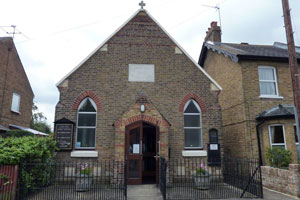
 and tricycle c 1900.jpg)
Eton Wick in the 1870s was a very small country village. Its houses, less than a hundred in number, were mainly concentrated between Bell Lane and Sheepcote Road, and between the Common and Eton Wick Road. There were several farms and farm cottages, and Bell Farm had recently been bought by the Eton Sanitary Authority for use as a sewage farm for Eton.
In 1877 Charles Tough, who had recently been employed as Farm Manager, married Frances Annie Moore from Rotherhithe. Annie, as she became known, was a wholehearted Christian who, on arrival in the village, set about sharing her faith.
By 1884 land just across the boundary had been bought and laid out into building plots, and new houses were under construction. Annie, supported by the Primitive Methodists in Queen Street Maidenhead, found a site for a church. With much persistence, she wore down the resistance of the developer until he gave her a plot "as a reward for her perseverance". The cost of building the church was £300, a large amount for such a small community to find.
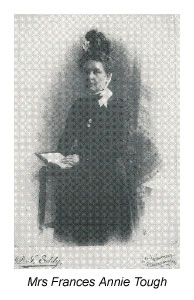
The Chapel was finished in 1886 and for the first 50 years, Methodist church life in the village was fairly constant but effective, attracting morning and evening congregations of 30 - 40 and an afternoon Sunday School of around 60 - 70 children of all ages. There was also a Sisterhood meeting for the ladies of the Chapel and a Men's Fireside which attracted members from the nearby Ledgers Road Church.
When on 9th June 1930 our founder Mrs Frances Annie Tough died, members decided to build the Tough Memorial Hall, together with toilets and kitchen in her honour. This was duly opened on 28th September 1935.
During the ensuing years the village expanded and the chapel catered for numerous activities such as:
- The Ladies Club formed in 1961 as a social group
- Carol & Mince Pie evenings — started Christmas 1965
- Sunday evening Prayer Meeting — formed in 1968 by Harry Cook
- Bible Study Group — started in 1982 by the Chew family
- Parents and Tots venture — launched in 1985 by Laura Clack
In 1986 the members re-decorated the whole building and erected the folding partition and curtaining to allow best use of the hall and sanctuary facilities for large meetings.
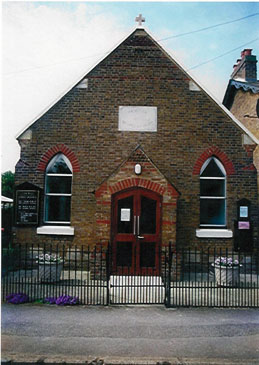
Death of several of our stalwart members failed to dishearten us, and by 1994 the second part of our Tough Assignment was launched with the momentous decision to completely refurbish the whole Chapel with up-to-date toilets and kitchen, to meet the exacting state-of-the-art Government Health and Safety regulations. This became known as the 2094 project because we were reaching out to the next hundred years. At this time "Seeking To Serve" became the driving principle of our membership.
The chapel was closed for about six months due to the refurbishment and during this time services were held at St Gilbert's Catholic Church while much of our furniture was kept in storage by the Anglicans. The three village churches grew much closer together at this time and when the renovated chapel was re-opened, a Service of Thanksgiving was shared with the Anglican and Catholic communities.
New individual seating was introduced to replace the old pews and a new pulpit was donated in memory of the Hogg family.
New ventures in the 1990s and early 2000s included:
- Community Care (mobile assistance for hospital and surgery visits)
- The Thursday Fellowship replacing the Sisterhood
- Wednesday Luncheon Club — started in February 1994
- Winter Pie and Praise evenings — started on 4th November 1997
- Village Singers — started in 2006 for people to express musical talents
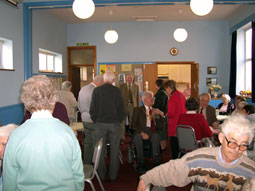
Over the years the Chapel had a reputation for being warm and welcoming and preachers and visitors alike enjoyed the friendly welcome they received. As with many Methodist Societies, food played an important part in the life of the church!
In the final stage of the Tough Assignment members sought to provide a centre for Village Community. With emphasis upon "our Faith being put into action", they continued to "Seek to Serve" their friends and neighbours by their Christian witness in Sunday Worship and the week-day events.
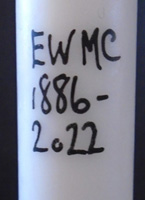
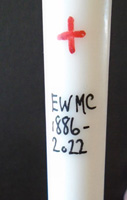
The members continued to meet faithfully over the years. However, the number attending dwindled considerably. This brought into question the continuing viability of the Society. In 2021 the Church Council decided to put in place an end of life plan, and at a later meeting – prayerfully but with sadness of heart – members voted to seek permission to cease to meet as a Society. In line with Methodist Standing Orders, assent was duly given by the Thames Valley Circuit Meeting and by the South East District Council. With the pastoral concerns of every member taken into account, the church held a final act of worship on Sunday, 9th January 2022 – a service celebrating all that the members had achieved in their witness over the years.
Tough Assignment - History of Eton Wick Chapel, 1886-1986 by Judith Hunter and Bob Jeffs.
The Thames Valley Circuit would like to express its appreciation to Eton Wick History Group for permission to reproduce the photograph of Alma Road, c 1900.